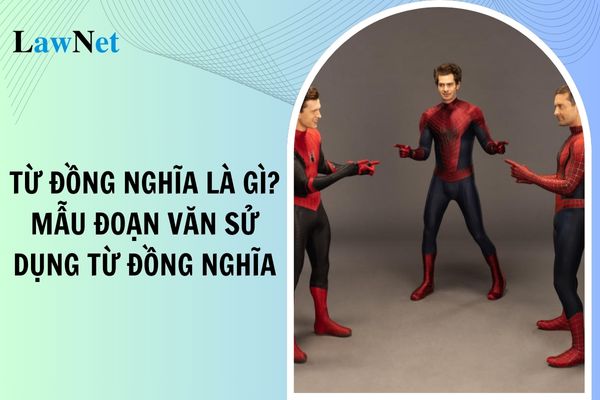What is a synonym in Vietnamese? What are sample paragraphs using synonyms? What knowledge is included in the grade 5 Vietnamese Language curriculum?
What is a synonym in Vietnamese? What are sample paragraphs using synonyms?
Concept of synonyms:
Synonyms are different words but have similar or nearly the same meanings in a certain context. They are often used to enrich expressions and avoid word repetition.
In literature, synonyms are used to:
- Enrich language: Using synonyms helps to avoid word repetition, making the text more diverse and lively.
- Enhance expression: Synonyms can convey different meanings in terms of degree, nuance, emotion.
- Emphasize and clarify ideas: Using synonyms helps to emphasize or clarify ideas in a sentence, paragraph, creating a stronger effect.
Examples of synonyms:
Hạnh phúc - Vui sướng
Dũng cảm - Can đảm
Khởi đầu - Bắt đầu
Xinh đẹp - Đẹp đẽ
Trí tuệ - Kiến thức
Nhanh chóng - Mau lẹ
Sample paragraphs using synonyms
Sample 1:
Trong một buổi sáng yên tĩnh và tĩnh lặng, tôi quyết định đi dạo quanh công viên. Không khí trong lành và sạch sẽ làm tôi cảm thấy thư thái và thoải mái. Những tia nắng ấm áp và nồng ấm chiếu qua tán lá cây, tạo nên những vệt sáng lung linh và lấp lánh trên mặt đất. Tiếng chim hót líu lo và ríu rít vang lên từ những cành cây cao, mang lại cảm giác bình yên và an bình.
Sample 2:
Buổi chiều, tôi ngồi bên cửa sổ, ngắm nhìn những đám mây trắng xóa và tinh khôi trôi lững lờ trên bầu trời. Gió nhẹ nhàng và dịu dàng thổi qua, mang theo hương thơm thoang thoảng và nhẹ nhàng của hoa cỏ. Cảnh vật xung quanh tĩnh lặng và yên tĩnh, chỉ có tiếng lá cây xào xạc và rì rào trong gió. Tôi cảm thấy thư thái và thoải mái, tận hưởng khoảnh khắc bình yên và an bình này.
Note: The content is for reference only!

What is a synonym in Vietnamese? What are sample paragraphs using synonyms? What knowledge is included in the grade 5 Vietnamese Language curriculum? (Image from the Internet)
What knowledge is included in the grade 5 Vietnamese Language curriculum?
According to the regulation in the Literature Curriculum of the General Education Program issued with Circular 32/2018/TT-BGDDT, grade 5 Vietnamese knowledge includes the following:
1.1. Rules for writing names of people, foreign geographical names
1.2. Certain cases of capitalizing common nouns to show special respect
2.1. Vocabulary based on key topics
2.2. Dictionary: how to find words, meanings of words, word usage, and searching for other information
2.3. Meanings of some easily understood and common idioms
2.4. Meanings of some common Sino-Vietnamese elements, "homophones with different meanings"
2.5. Synonyms: characteristics and effects
2.6. Polysemous words and meanings of polysemous words in texts.
3.1. Pronouns and conjunctions: characteristics and functions
3.2. Simple and compound sentences: characteristics and functions
3.3. Uses of the dash (placed in the middle of a sentence to mark explanatory parts in a sentence); hyphen (connects syllables in borrowed words comprising multiple syllables)
4.1. Rhetorical devices of repeated words and phrases: characteristics and effects
4.2. Linking sentences within a paragraph, some linking sentence measures and linking words: characteristics and effects
4.3. Types and genres of texts
- Essay concluding a story
- Essays describing people, landscapes
- Paragraphs expressing emotions and feelings towards an event, poem, story
- Paragraphs stating opinions on a social phenomenon
- Essays explaining a natural phenomenon, introducing books or films, work reports, activity programs, using tables; advertising texts (leaflets, posters,...)
5.Information through images, data (non-verbal communication means).
What are requirements for grade 5 literacy competence in Vietnam?
In the Literature Curriculum of the General Education Program issued with Circular 32/2018/TT-BGDDT:
Literary Competence
Distinguish between narrative and poetic texts (paragraphs, prose pieces, and paragraphs, versified writings); identify the text content and the attitude, feelings of the writer; initially understand the impact of some formal elements of literary texts (words, characters, plot, verse, comparisons, personification). Know how to associate, imagine and express with literary qualities in writing and speaking.
For students in Grades 1 and 2: identify who or what the text is about; recognize characters in stories, rhyme in poems; distinguish between stories and poems.
For students in Grades 3, 4, and 5: know how to read literary texts expressively; recount, summarize the main content of a story, poem; comment on characters, events, and the attitude, feelings of the writer in the text; recognize time and place, some types of verse, rhythm, beautiful, unique words, images and the effects of rhetorical devices of personification and comparison. Understand the significance or lesson from the text. Write paragraphs, stories, descriptive essays expressing emotions and imagination ability.
Thus, the requirements for Grade 5 literacy competence are as follows:
- Know how to read literary texts expressively; recount, summarize the main content of a story, poem; comment on characters, events, and the attitude, feelings of the writer in the text;
- Recognize time and place, some types of verse, rhythm, beautiful, unique words, images, and the effects of rhetorical devices of personification and comparison.
- Understand the significance or lesson drawn from the text. Write stories, descriptive essays expressing emotions and imagination ability.

